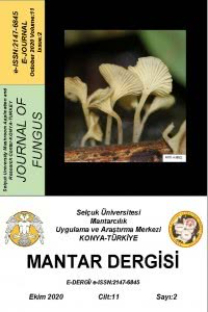Yenilebilir Bir Tür Olan Lycoperdon utriformis Bull.’in Yağ Asit Kompozisyonlarının Gaz Kromatoğrafisi(GC)’de Tayin Edilmesi
Afyon, Ladik (Samsun) ve Manavgat (Antalya) bölgelerinden toplanan mantar örnekleri kurutulup, teşhisleri yapıldıktan sonra birleştirilerek tek bir numune halinde sürekli ekstraksiyon yöntemiyle elde edilen ekstraktının esterleşme reaksiyonları yapılarak yağ asit kompozisyonları tayin edilmiştir. Lycoperdon utriformis Bull. türünün tayin edilen yağ asiti kompozisyonları kromatoğram ve tablo halinde verilmiştir. Elde edilen sonuçlara göre, Lycoperdon utriformis’te oleik asit (%7.75), stearik asit (%7.63) ve α-linolenik asit (%6) yüzdelerinin en yüksek düzeylerde olduğu belirlenmiştir.
Anahtar Kelimeler:
Lycoperdon utriformis, Sürekli Ekstraksiyon, Yağ asiti kompozisyonu, GC
Determination of the Fatty Acid Compositions in Edible Species Lycoperdon utriformis Bull. by Gas Chromatography (GC)
Fungal samples collected from Afyon, Ladik (Samsun) and Manavgat (Antalya) regions were dried and combined with each other after their diagnosis. Fatty acid compositions were determined by performing esterification reactions of the extract obtained by continuous extraction as a single sample lycoperdon utriformis Bull. The fatty acid compositions determined for the test are given in chromatography and tabular form. According to the results obtained, the highest levels of oleic acid (7.75%), stearic acid (7.63%) and α-linolenic acid (6%) were found in Lycoperdon utriformis.
Keywords:
Lycoperdon utriformis, Fatty Acid composition, Continuous Extraction, GC,
___
- Ayaz F.A., Chuang L.T., Torun H.L., Çolak A., Sesli E., Presley J., Smith B.R., Glew R.H., Fatty acid and amino acid compositions of selected wild-edible mushrooms consumed in Turkey, International Journal of Food Sciences and Nutrition, 62(4): 328–335 (2011).
- Barros L., Baptista P., Correia D.M., Casal S., Oliveira B., Ferreira I.C.F.R., Fatty acid and sugar compositions, and nutritional value of five wild edible mushrooms from Northeast Portugal, Food Chemistry, 105:140-145 (2007).
- Breitenbach J., Kränzlın F., Fungi of Switzerland, Volume 1-5. Verlag Mykologia CH-6000 Luzern 9, Switzerland (1983-2005).
- Dähncke R.M., 1200 Pilze, AT Verlag Aarau, Stuttgart (1993).
- Diez V.A., Alvarez A., Compositional and nutritional studies on two wild edible mushrooms from northwest Spain, Food Chemistry, 75:417–422 (2001).
- Doğan H.H., Akbaş G., Biological activity and fatty acid composition of Caesar’s mushroom, Pharm Biol, 51(7): 863–871 (2013).
- Ergönül G., Akata I, Kalyoncu F, Ergönül B., Fatty Acid Compositions of Six Wild Edible Mushroom Species, Scientific World Journal, Jun 6;2013:163964 (2013).
- Ellis M.B., Ellis J.P., Fungi Without Gills (Hymenomycetes and Gasteromycetes), Chapman and Hill, London (1990).
- Guillamón E., García-Lafuente A., Lozano M., D´Arrigo M., Rostagno M.A., Villares A., Martínez J.A., Edible mushrooms: Role in the prevention of cardiovascular diseases, Fitoterapia, 81:715–723 (2010).
- Heleno S.A., Barros L., Sousa M.J., Martins A., Ferreira I.C.F.R., Study and characterization of selected nutrients in wild mushrooms from Portugal by gas chromatography and high performance liquid chromatography, Microchemical Journal, 93:195-199 (2009)
- Jordan K., The New Guide to Mushrooms, Anness Publishing Ltd., Singapore (1996).
- Kavishree S., Hemavathy J., Lokesh B.R., Shashirekha M.N., Rajarathnam S., Fat and fatty acids of Indian edible mushrooms, Food Chemistry, 106:597-602 (2008)
- Kreisel H., Grundzüge Eines Natürlichen Systems der Pilze, Verlag Von J. Cramer, Stuttgart (1969).
- Liu G., Wang H., Zhou B., Guo X., Hu X., Compositional analysis and nutritional studies of Tricholoma matsutake collected from Southwest China, Journal of Medicinal Plants Research, 4(12):1222-1227 (2010).
- Moser M., Keys to Agarics and Boleti, Gustav Fischer Verlag, Stuttgart (1983).
- Pedneault K., Angers P., Gosselin A., Tweddell R.J., Fatty acid composition of lipids from mushrooms belonging to the family Boletaceae, Mycological Research, 110:1179-1183 (2006).
- Pedneault K., Angers P., Avis T.J., Gosselin A., Tweddell R.J., Fatty acid profiles of polar and non-polar lipids of Pleurotus ostreatus and P. cornucopiae var. ‘citrino-pileatus’ grown at different temperatures, Mycological Research, 111:1228-1234 (2007).
- Pereira E., Barros L., Martins A., Ferreira I.C.F.R., Towards chemical and nutritional inventory of Portuguese wild edible mushrooms in different habitats, Food Chemistry, 130: 394–403 (2012).
- Phillips R., Mushrooms and Other Fungi of Great Britain and Europe, Pan Books Ltd., London (1981).
- Ribeiro B., de Pinho P.G., Andrade P.B., Baptista P., Valentão P., Fatty acid composition of wild edible mushrooms species: A comparative study, Microchemical Journal, 93:29–35 (2009).
- Sesli, E., Denchev, C.M., Checklists of the myxomycetes, larger ascomycetes, and larger basdiomycetes in Turkey. 6th edn. Mycotaxon Checklists Online (2014). (http://www.mycotaxon.com/resources/ checkilsts/sesli-v106-checklist.pdf): 1–136. Üstün O., Makrofungusların besin değeri ve biyolojik etkileri, Türk Hijyen ve Deneysel Biyoloji Dergisi, 68(4): 223-240 (2011).
- Valverde M.E., Hernández-Pérez T., Paredes-López O., Edible Mushrooms: Improving Human Health and Promoting Quality Life, International Journal of Microbiology, 2015:376387 (2015).
- Watling R., Identification of The Larger Fungi, Hulton Educational Publications Ltd (1973).
- Winkler R., 2000 Pilze Einfach Bestimmen, ATV. Aarau, Schweiz (1996).
- Yılmaz A., Yıldız S., Yıldırım İ., Aydın A., Trabzon'da Mantar Tüketimi ve Tüketim Alışkanlıklarının Belirlenmesi, Mantar Dergisi/The Journal of Fungus, 7(2)135-142 (2016).
- Yilmaz N., Solmaz M., Türkekul İ., Elmastaş M., Fatty acid composition in some wild edible mushrooms growing in the middle Black Sea region of Turkey, Food Chemistry, 99:168-174 (2006).
- ISSN: 2147-6845
- Yayın Aralığı: Yılda 2 Sayı
- Başlangıç: 2010
- Yayıncı: Selçuk Üniversitesi Mantarcılık Uygulama ve Araştırma Merkezi Müdürlüğü
Sayıdaki Diğer Makaleler
Türkiye Clathroid Mantarları İçin Yeni Bir Cins Kaydı
ILGAZ AKATA, CEM TOLGA GÜRKANLI
Kazdağı’ndan (Balıkesir, Türkiye) Likenleşmiş ve Likenikol Mantar Kayıtları
SEYHAN ORAN, Gülşah ÖZYİĞİTOĞLU, ŞULE ÖZTÜRK
Elçin TUNEY, AHMET ASAN, BURHAN ŞEN
Marasmiellus vaillantii (Pers.) Singer (Omphalotaceae), Türkiye Mikotası İçin Yeni Bir Kayıt
Cortinarius ve Lyophyllum cinslerine ait yeni kayıtlar
Ahmet ASAN, Elcin TUNEY, Burhan SEN
Sema Aşkın KEÇELİ, Selim ÖNCEL
